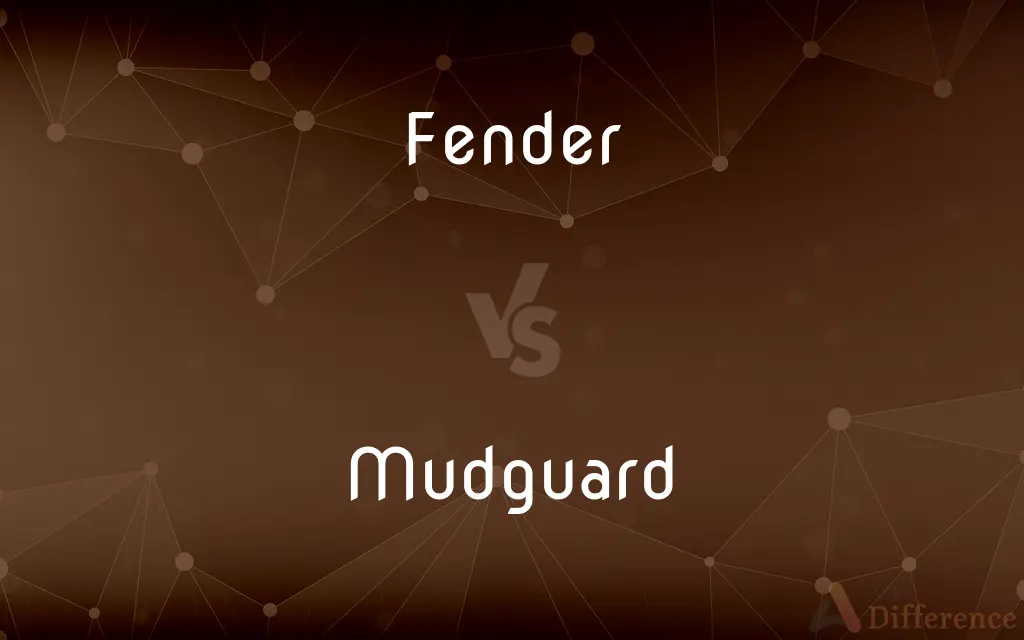Fender vs. Mudguard — What's the Difference?
Edited by Tayyaba Rehman — By Maham Liaqat — Updated on May 7, 2024
A fender is a vehicle component that covers the wheel to protect the body from mud and debris, primarily on cars, while a mudguard is an attachment that shields bicycle or motorcycle wheels from splashes.

Difference Between Fender and Mudguard
Table of Contents
ADVERTISEMENT
Key Differences
A fender, often seen on cars and trucks, is a part of the body directly attached over the wheel well to protect the vehicle from mud and road debris. A mudguard, on the other hand, is a detachable accessory fitted onto bicycles and motorcycles, offering similar protection but designed specifically for these smaller vehicles.
Fenders are integrated into the vehicle’s bodywork and can be either front or rear. Mudguards are more flexible, easily added or removed depending on road conditions and specific user needs.
Fenders have a broader structural purpose, providing aesthetic continuity and sometimes reducing aerodynamic drag. Mudguards focus exclusively on preventing water, mud, or debris from reaching the rider or the bike's critical components.
Fenders are usually metal or plastic, blending with the vehicle’s design. Mudguards are lightweight, often made of plastic or rubber, to remain efficient without adding significant weight to the bike.
Fenders offer comprehensive wheel coverage and often require specific maintenance or repair due to collisions. Mudguards, however, are relatively inexpensive and are easily replaced.
ADVERTISEMENT
Comparison Chart
Purpose
Protects car body from mud and debris
Prevents splashes from wheels
Application
Cars and trucks
Bicycles and motorcycles
Integration
Integrated into vehicle body
Attached as an external accessory
Material
Metal or plastic
Plastic or rubber
Removal
Requires more effort
Easily attachable/detachable
Compare with Definitions
Fender
A part responsible for covering the wheels and preventing road debris.
Fenders are crucial to protecting the car’s paint.
Mudguard
A protective shield above a wheel, especially on motorcycles.
The mudguard kept the motorbike’s engine free of mud.
Fender
A panel covering a vehicle's wheel well.
The car's fender was dented in the collision.
Mudguard
A cover placed over a bicycle wheel to prevent splashes.
The cyclist added mudguards to his bike for the rainy season.
Fender
A structural vehicle component that aligns with the exterior design.
The fender design is crucial for aerodynamic efficiency.
Mudguard
A flexible shield to protect riders and passengers from water.
After the heavy rains, the mudguard was completely caked.
Fender
A body panel designed to prevent mud from reaching the vehicle’s sides.
After the muddy trail, the fenders needed thorough cleaning.
Mudguard
A detachable covering that reduces spray from the wheels.
Mudguards can be attached or removed depending on road conditions.
Fender
A side structure that may include wheel arches.
He inspected the fender for any signs of rust.
Mudguard
An attachable accessory designed for riding in wet conditions.
He removed the mudguard after the weather improved.
Fender
A guard over each wheel of a motor vehicle, for example, that is shaped and positioned so as to block the splashing of water or mud.
Mudguard
A shield over or behind a vehicle's wheel to prevent mud or water from splashing onto that vehicle or a following vehicle. Also called splashguard.
Fender
A device at the front end of a locomotive or streetcar designed to push aside obstructions.
Mudguard
A strip of leather, rubber, or other material added to the upper of a shoe just above the sole as protection against mud and water or as a decoration.
Fender
A cushioning device, such as a bundle of rope or a piece of timber, used on the side of a vessel or dock to absorb impact or friction.
Mudguard
A cover over the wheels of a vehicle, or a flap behind that wheel, to prevent water and mud being projected.
Fender
A screen or metal framework placed in front of a fireplace to keep hot coals and debris from falling out.
Mudguard
A curved piece above the wheel of a bicycle or motorcycle to protect the rider from water or mud thrown up by the wheels
Fender
(US) panel of a car which encloses the wheel area, especially the front wheels.
Fender
(US) a shield, usually of plastic or metal, on a bicycle that protects the rider from mud or water
Fender
(nautical) any shaped cushion-like object normally made from polymers, rubber or wood that is placed along the sides of a boat to prevent damage when moored alongside another vessel or jetty, or when using a lock, etc. Modern variations are cylindrical although older wooden version and rubbing strips can still be found; old tyres are used as a cheap substitute
Fender
A low metal framework in front of a fireplace, intended to catch hot coals, soot, and ash
Fender
(nautical) To use fenders to protect the side of a boat
Fender
One who or that which defends or protects by warding off harm
Fender
A barrier that surrounds the wheels of a vehicle to block splashing water or mud;
In England they call a fender a wing
Fender
An inclined metal frame at the front of a locomotive to clear the track
Fender
A low metal guard to confine falling coals to a hearth
Fender
A cushion-like device that reduces shock due to contact
Common Curiosities
How do mudguards differ from fenders?
Mudguards are specifically designed for bicycles or motorcycles, while fenders are integral to car and truck bodywork.
What materials are mudguards made from?
They are typically made from plastic or rubber for lightweight flexibility.
Are mudguards mandatory on bicycles?
Not mandatory, but they are highly recommended in wet or muddy conditions.
What is the primary function of a fender?
Fenders protect the vehicle body from mud, debris, and damage.
Do mudguards require maintenance?
Yes, occasional cleaning and checking attachment points ensure proper functioning.
Do fenders increase a vehicle's weight significantly?
Not significantly, as they are designed to integrate smoothly into the vehicle body.
Can fenders be removed or replaced easily?
Replacing fenders requires more effort because they are an integral body part.
Do fenders provide aesthetic benefits for cars?
Yes, fenders offer a seamless appearance and can improve aerodynamics.
Can mudguards be used on all bicycle types?
Yes, mudguards are available in various designs to suit different bicycles.
Are mudguards easily installed?
Yes, many are designed for simple attachment using clamps or bolts.
Can fenders be repaired after damage?
Depending on the damage, fenders can often be repaired or replaced.
Can fenders or mudguards impact safety?
Yes, both provide protection from debris and help maintain visibility.
Do fenders or mudguards affect a vehicle’s performance?
They can influence aerodynamics but are primarily designed to protect the vehicle.
How do fenders and mudguards handle rust or wear?
Regular maintenance is essential to prevent rust on fenders, while plastic mudguards resist rust.
Are custom fenders and mudguards available?
Yes, many manufacturers offer custom designs to match vehicle styles or needs.
Share Your Discovery

Previous Comparison
Rationale vs. Significance
Next Comparison
Papain vs. PepsinAuthor Spotlight
Written by
Maham LiaqatEdited by
Tayyaba RehmanTayyaba Rehman is a distinguished writer, currently serving as a primary contributor to askdifference.com. As a researcher in semantics and etymology, Tayyaba's passion for the complexity of languages and their distinctions has found a perfect home on the platform. Tayyaba delves into the intricacies of language, distinguishing between commonly confused words and phrases, thereby providing clarity for readers worldwide.













































